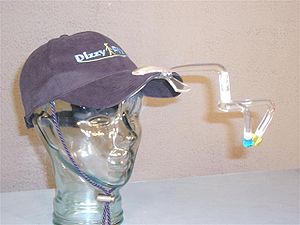
DizzyFIX
Encyclopedia

Epley maneuver
The Epley maneuver is a maneuver used to treat benign paroxysmal positional vertigo . It is often performed by a doctor, chiropractor, or a physical therapist, after confirmation of a diagnosis of BPPV using the Dix-Hallpike . This maneuver was developed by Dr. John Epley and first described in 1980...
.
BPPV

Background
The DizzyFIX was originally developed by otolaryngologists (ENT physicians) to assist in the long term treatment of patients with a known history of recurrent BPPV. BPPV is frequently highly recurrent with rates as high as 50%. Radtke et al. have suggested that home treatment is both safe and effective when training is adequate but that the key cause of failure of the home treatment is an imperfect repositioning maneuver. As a result of failed home treatments the DizzyFIX was developed to assist patients in the performance of a correct particle repositioning maneuver. Research to date indicates that use of the device is correlated with a correct particle repositioning maneuver (Beyea, 2007).The device was subsequently manufactured by Clearwater Clinical of Calgary
Calgary
Calgary is a city in the Province of Alberta, Canada. It is located in the south of the province, in an area of foothills and prairie, approximately east of the front ranges of the Canadian Rockies...
, Alberta
Alberta
Alberta is a province of Canada. It had an estimated population of 3.7 million in 2010 making it the most populous of Canada's three prairie provinces...
and further research was undertaken at the University of Western Ontario
University of Western Ontario
The University of Western Ontario is a public research university located in London, Ontario, Canada. The university's main campus covers of land, with the Thames River cutting through the eastern portion of the main campus. Western administers its programs through 12 different faculties and...
, London, Ontario
London, Ontario
London is a city in Southwestern Ontario, Canada, situated along the Quebec City – Windsor Corridor. The city has a population of 352,395, and the metropolitan area has a population of 457,720, according to the 2006 Canadian census; the metro population in 2009 was estimated at 489,274. The city...
.
Global News reported on the DizzyFIX on April 2, 2009. (YouTube Video)
On May 19, 2010 The Discovery channel conducted an interview dealing with the DizzyFIX device and an iPhone app which can help doctors perform the maneuver more easily. (Discovery Channel Video Clip)
Research
Bromwich et al. measured the impact that DizzyFIX had on volunteers' ability to perform the Epley maneuverEpley maneuver
The Epley maneuver is a maneuver used to treat benign paroxysmal positional vertigo . It is often performed by a doctor, chiropractor, or a physical therapist, after confirmation of a diagnosis of BPPV using the Dix-Hallpike . This maneuver was developed by Dr. John Epley and first described in 1980...
. Reports indicated that the DizzyFIX improves accuracy by comparison to instructions and expert training alone. The design and development of the device is also described.
Beyea et al. used the DizzyFIX as an objective measure of a various methods of medical education. DizzyFIX outcome was compared with objective observers of participants performance.
Research dealing with the design and clinical application of the device was published in the July edition of Archives of Otolaryngology. The researchers gave the DizzyFIX to 40 patients suffering from BPPV. After one week of home treatment, 35 patients (88 percent) had no evidence of BPPV.
Device certification
- The DizzyFIX is FDA cleared for use in the USA.(K081602)
- The DizzyFIX is CE registered in the European Union.
- The DizzyFIX device is a Class I medical deviceMedical deviceA medical device is a product which is used for medical purposes in patients, in diagnosis, therapy or surgery . Whereas medicinal products achieve their principal action by pharmacological, metabolic or immunological means. Medical devices act by other means like physical, mechanical, thermal,...
according to Rule 7(1) of the Medical Devices Regulations and has been reviewed and determined to be such by the Device Licensing section of the Medical Devices Bureau of Health CanadaHealth CanadaHealth Canada is the department of the government of Canada with responsibility for national public health.The current Minister of Health is Leona Aglukkaq, a Conservative Member of Parliament appointed to the position by Prime Minister Stephen Harper.-Branches, regions and agencies:Health Canada...
. - The DizzyFIX complies with Canada's Medical Devices Regulations, which include: safety and effectiveness (Sections 10 to 20, 21 to 23, 52 to 58, 59 to 62, and 63 to 65). It also complies with the requirements of Sections 3 and 19 to 21 of Canada's Food and Drugs Act.
See also
- BPPV
- Balance disorderBalance disorderA balance disorder is a disturbance that causes an individual to feel unsteady, for example when standing or walking. It may be accompanied by feelings of giddiness or wooziness, or having a sensation of movement, spinning, or floating...
- Nystagmus
- Vestibular systemVestibular systemThe vestibular system, which contributes to balance in most mammals and to the sense of spatial orientation, is the sensory system that provides the leading contribution about movement and sense of balance. Together with the cochlea, a part of the auditory system, it constitutes the labyrinth of...
External links
- DizzyFIX Home treatment device
- Feature Article - Calgary Herald "Fixing the Dizzies - Michelle Magnan"
- Feature Article - Reuters Device combats common cause of vertigo
- University of Western Ontario
- Clearwater Clinical Limited Medical Technology
- Dizzytimes.com Online Community for Sufferers of Vertigo and Dizziness
- DizzyFIX in the UK BPPV & how the device can help

